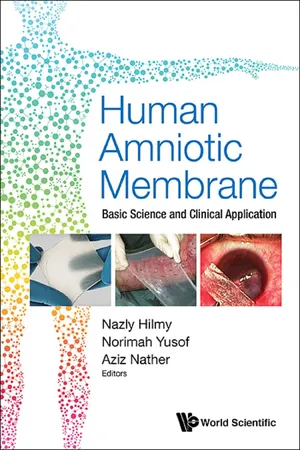
Human Amniotic Membrane: Basic Science And Clinical Application
Basic Science and Clinical Application
- 380 pages
- English
- ePUB (mobile friendly)
- Available on iOS & Android
Human Amniotic Membrane: Basic Science And Clinical Application
Basic Science and Clinical Application
About This Book
-->
This book is a comprehensive guide for all tissue bank operators to screen, procure and process amniotic membrane for clinical application.
The amnion comes close to being the ideal biological membrane or dressing — readily available, inexpensive to procure and process. Its basic science is discussed in detail — anatomy, biological and biomechanical properties.
It can be procured from the placenta in normal vaginal deliveries and from Caesarean Sections. Processing is by freeze-drying or by air-drying process with sterilisation using gamma irradiation.
The product has low antigenicity, has anti-microbial properties with ability to enhance epithelisation with marked relief of pain. It is useful as a dressing for wounds — flap wounds, burn wounds, injury wounds, diabetic ulcers, leprous ulcers and post-surgery wounds and post-radiation wounds. It is also used as a biological scaffold for cells in tissue engineering. Its ophthalmic applications include treatment of corneal ulcers and conjunctival tumours. Oral uses include gingiva depigmentation and periodontal regeneration.
--> Contents:
- Section I: Introduction:
- IAEA Programmes in Tissue Banking in Asia-Pacific Region (Nazly Hilmy and Norimah Yusof)
- Tissue Banking in Asia Pacific Region: Past, Present, Future (Aziz Nather, Foong Shi Yun Mandy, Tan Ning and Wang Kaiying)
- Training Tissue Bank Operators — 20 Years of Experience by IAEA/NUS Regional Training Centre (Aziz Nather and Wo Yu Jun)
- Section II: Historical Development and Basic Science:
- Historical Development of Amnion (Norimah Yusof and Nazly Hilmy)
- Anatomy and Histology of Amnion (Nazly Hilmy and Norimah Yusof)
- Biological Properties and Functions of Amnion (Paramita Pandansari, Retno Dwijartini Tantin, Basril Abbas and Nazly Hilmy)
- Physical Properties of Amnion (Norimah Yusof and Nazly Hilmy)
- Section III: Screening, Procurement and Processing:
- Transmissible Diseases (Aziz Nather, Sherilyn Leong Li Juan and Wo Yu Jun)
- Donor Suitability (Aziz Nather, Wo Yu Jun, Sherilyn Leong Li Juan, Norimah Yusof and Nazly Hilmy)
- Procurement and Processing of Amniotic Membrane (Nazly Hilmy and Norimah Yusof)
- Section IV: Sterilisation and Quality Control:
- Sterilisation of Amnion (Norimah Yusof and Nazly Hilmy)
- Routine Quality Control of Processed Amniotic Membrane (Norimah Yusof and Nazly Hilmy)
- Section V: Clinical Applications:
- Management of Wounds:
- Use of Amnion in Plastic Surgery (Ahmad Sukari Halim, Leow Aik Ming, Aravazhi Ananda Dorai and Wan Azman Wan Sulaiman)
- Role of Amnion for Treating Burns (Hasim Mohamad)
- Role of Amnion for Healing of Wounds (Menkher Manjas, Petrus Tarusaraya and Nazly Hilmy)
- Amnion Dressing in the Management of Radiation Skin Reaction Following Post Radiotherapy (Menkher Manjas)
- Ophthalmic Applications:
- Freeze-Dried Irradiated Amnion in Ophthalmic Surgery (Nazly Hilmy, Paramita Pandansari, Getry Sukmawati Ibrahim, S Indira, S Bambang, Radiah Sunarti and Susi Heryati)
- Multi Layer Amniotic Membrane Transplantation (MLAMT) for Ocular Reconstruction (Getry Sukmawati Ibrahim and Havriza Vitresia)
- Oral Cavity Applications:
- Gingiva Depigmentation Using Amniotic Membrane (Retno Dwijartini Tantin, Basril Abbas, Paramita Pandansari and Nazly Hilmy)
- Amniotic Membrane in Periodontal Regeneration (Shaila Kothiwale)
- Management of Wounds:
-->
--> Readership: This book will serve as a useful guide to tissue bank operators in the Asia Pacific region including China, Hong Kong, Korea, Japan, Bangladesh, India, Indonesia, Malaysia, Myanmar, Pakistan, Philippines, Sri Lanka, Thailand, Vietnam and Singapore. -->
Keywords:Human Amniotic Membrane;Basic Science;Clinical Application;Radiation SterilisedReview: Key Features:
- First book on Amnion Membrane Allograft in the world
- Part of tissue banking curriculum of Diploma Course in Tissue Banking run by IAEA and NUS annually since 1997
- Will become textbook for all diploma course students
Frequently asked questions
Information
Management of Wounds
13
Use of Amnion in Plastic Surgery
Table of contents
- Cover
- Halftitle
- Title
- Copyright
- Dedication
- Lifetime Achievement Awards
- Preface
- About the Editors
- List of Contributors
- Contents
- Section I: Introduction
- Section II: Historical Development and Basic Science
- Section III: Screening, Procurement and Processing
- Section IV: Sterilisation and Quality Control
- Section V: Clinical Applications